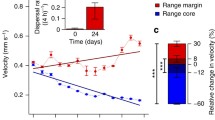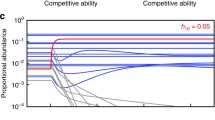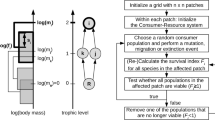Abstract
There is substantial evidence that environmental changes on a landscape level can have dramatic consequences for the species richness and structure of food webs as well as on trophic interactions within such food webs. Thus far, the consequences of environmental change, and particularly the effects of invasive species and the fragmentation and isolation of natural habitats, have most often been studied in a purely ecological context, with the main emphasis on the description of alterations in species abundance and diversity and trophic links within food webs. Here, we argue that the study of evolutionary processes that may be affected by such changes is urgently needed to enhance our understanding of the consequences of environmental change. This requires an approach that treats species as dynamic systems with plastic responses to change rather than as static entities. As such, phenotypic plasticity on an individual level and genotypic change as a population level response should be taken into account when studying the consequences of a changing world. Using a multidisciplinary approach, we report on recent advances in our understanding, identify some major gaps in our current knowledge, and point towards rewarding approaches to enhance our understanding of how environmental change alters trophic interactions and ecosystems.
Similar content being viewed by others
References
Aarts BGW Van den, Brink FWB, Nienhuis PH. 2004. Habitat loss as the main cause of the slow recovery of fish faunas of regulated large rivers in Europe: The transversal floodplain gradient. River Res Appl 20:3–13
Agrawal AA. 2001. Phenotypic plasticity in the interactions and evolution of species. Science 294:321–6
Agrawal AA. 2003. Community genetics: new insights into community ecology by integrating population genetics. Ecology 84:543–4
Agrawal AA, Kotanen PM. 2003. Herbivores and the success of exotic plants: a phylogenetically controlled experiment. Ecol Lett 6:712–5
Alpine AE, Cloern JE. 1992. Trophic interactions and direct physical effects control phytoplankton biomass and production in an estuary. Limnology and Oceanography 37:946–55
Anderson JM, Hetherington SL. 1999. Temperature, nitrogen availability and mixture effects on the decomposition of heather (Calluna vulgaris (L.) Hull) and bracken (Pteridium aquilinum (L.) Kuhn) litters. Funct Ecol 13:116–124
Bernstein C, Kacelnik A, Krebs JR. 1991. Individual decisions and the distribution of predators in a patchy environment. II. The influence of travel cost and structure of the environment. J Anim Ecol 60:205–225
Blossey B, Nötzold R. 1995. Evolution of increased competitive ability in invasive nonindigenous plants: a hypothesis. J Ecol 83:887–9
Bolger DT, Suarez AV, Crooks KR, Morrison SA, Case TJ. 2000. Arthropods in urban habitat fragments in Southern California: Area, age, and edge effects. Ecol Appl 10:1230–48
Bruhl CA, Eltz T, Linsenmair KE. 2003. Size does matter – effects of tropical rainforest fragmentation on the leaf litter ant community in Sabah, Malaysia. Biodiv Conserv 12:1371–89
Carr DE, Eubanks MD. 2002. Inbreeding alters resistance to insect herbivory and host plant quality in Mimulus guttatus (Scrophulariaceae). Evolution 56:22–30
Carroll SP, Dingle H, Famula TR, Fox CW. 2001. Genetic architecture of adaptive differentiation in evolving host races of the soapberry bug, Jadera haematoloma. Genetica 112:257–72
Chauvel A and others. 1999. Pasture damage by an Amazonian earthworm. Nature 398:32–33
Cook WM, Anderson RM, Schweiger EW. 2004. Is the matrix really inhospitable? Vole runway distribution in an experimentally fragmented landscape. Oikos 104:5–14
Crooks JA. 2002. Characterizing ecosystem-level consequences of biological invasions: the role of ecosystem engineers. Oikos 97:153–66
da Silva JMC, Tabarelli M. 2000. Tree species impoverishment and the future flora of the Atlantic forest of northeast Brazil. Nature 404:72–4
Daehler CC, Strong DR. 1997. Reduced herbivore resistance in introduced smooth cordgrass (Spartina alterniflora) after a century of herbivore-free growth. Oecologia 110:99–108
Dubbert M, Tscharntke T, Vidal S. 1998. Stem-boring insects of fragmented Calamagrostis habitats: herbivore-parasitoid community structure and the unpredictability of grass shoot abundance. Ecol Entomol 23:271–80
Ellers J. 1997. Life history evolution in Asobam tabida: plasticity in allocation of fat reserves to survival and reproduction. J Evol Biol 10:771–85
Ellstrand NC, Elam DR. 1993. Population genetic consequences of small population size – Implications for plant sconservation. Annu Rev Ecol Syst 24:217–42
Ellstrand NC, Schierenbeck KA. 2000. Hybridization as a stimulus for the evolution of invasiveness in plants? Proc Nat Acad U S A 97:7043–50
Forstmeier W, Weiss I. 2004. Adaptive plasticity in nest-site selection in response to changing predation risk. Oikos 104:487–99
Garcia-Rossi D, Rank N, Strong DR. 2003. Potential for self-defeating biological control? Variation in herbivore vulnerability among invasive Spartina genotypes. Ecol Appl 13:1640–9
Gascon C, Malcon JR, Patton JL, da Silva MNF, Bogart JP, Lougheed SC, Peres CA, Neckel S, Boag PT. 2000. Riverine barriers and the geographic distribution of Amazonian specie. Proc Nat Acad Sci U S A 97:13672–7
Goverde M, Schweizer K, Baur B, Erhardt A. 2002. Small-scale habitat fragmentation effects on pollinator behaviour: experimental evidence from the bumblebee Bombus veteranus on calcareous grasslands. Biol Conserv 104:293–9
Gray AJ, Marshall DF, Raybould AF. 1991. A Century of Evolution in Spartina anglica. Adv Ecol Res 21:1–62
Hess GR. 1994. Conservation corridors and contagious disease – A cautionary note. Conserv Biol 8:256–62
Hill JK, Thomas CD, Blakeley DS. 1999. Evolution of flight morphology in a butterfly that has recently expanded its geographic range. Oecologia 121:165–70
Hoballah ME, Köllner DG, Degenhardt J, Turlings TCJ. 2004. Costs of induced volatile production in maize. Oikos 105:168–80
Hochberg ME, Möller AP. 2001. Insularity and adaptation in coupled victim-enemy associations. J Evol Biol 14:539–551
Holt R. 1997. From metapopulation dynamics to community structure. Consequences of spatial heterogeneity. Hanski I, Gilpin ME, Eds. Metapopulation Biology Ecology, genetics and evolution. San Diego: Academic Press, p 149–64
Holt RD, Lawton JH, Polis GA, Mailinez ND. 1999. Trophic rank and the species-area relationship. Ecology 80:1495–1504
Hughes CL, Hill JK, Dytham C. 2003. Evolutionary trade-offs between reproduction and dispersal in populations at expanding range boundaries. Proc R Soc Lond B Biol Sci 270:S147–S150
Hunter MD. 2002. Landscape structure, habitat fragmentation, and the ecology of insects. Agric Forest Entomol 4:159–66
Inoue K. 1993. Evolution of mutualism in plant-pollinator interactions on islands. J Biosci 18:525–536
Jakobs G, Weber E, Edwards PJ. 2004. Introduced plants of the invasive Solidago gigantea (Asteraceae) are larger and grow denser than conspecifics in the native range. Divers Distrib 10:11–9
Johst K, Drechsler M. 2003. Are spatially correlated or uncorrelated disturbance regimes better for the survival of species? Oikos 103:449–56
Keller LF, Waller DM. 2002. Inbreeding effects in wild populations. Trends Eco Evol 17:230–41
Krawchuk MA, Taylor PD. 2003. Changing importance of habitat structure across multiple spatial scales for three species of insects. Oilcos 103:153–61
Kruess A, Tscharntke T. 2000. Species richness and parasitism in a fragmented landscape: experiments and field studies with insects on Vicia sepium. Oecologia 122:129–37
Lank DB, Butler RW, Ireland J, Ydenberg R. 2003. Effects of predation danger on migration strategies of sandpipers. Oikos 103:303–19
Lee CE. 2002. Evolutionary genetics of invasive species. Trends Ecol Evol 17:386–91
Leger EA, Rice KJ, 2003. Invasive California poppies (Eschscholzia californica Cham.) grow larger than native individuals under reduced competition. Ecol Lett 6:257–64
Lehtonen T, Lindström K. 2004. Changes in sexual selection resulting from novel habitat use in the sand goby. Oikos 104:327–35
Lennon JT, Smith VH, Dzialowski AR. 2003. Invasibility of plankton food webs along a trophic state gradient. Oikos 103:191–203
Manel S, Schwartz MK, Luikart G, Taberlet P. 2003. Landscape genetics: combining landscape ecology and population genetics. Trends Ecolgy Evol 18:189–97
McCallum H, Dobson A. 2002. Disease, habitat fragmentation and conservation. Proc R Soc Londo B Biol Sci 269:2041–9
Mitchell CE, Power AG. 2003. Release of invasive plants from fungal and viral pathogens. Nature 421:625–7
Mooney HA, Cleland EE. 2001. The evolutionary impact of invasive species. Proc Nat Acad Sci U S A 98:5446–51
Moore JP, Dynes C, Murchie AK, Yeates GW. 1998. Status and public perception of the ‘New Zealand flatworm’, Artioposthia triangulate (Dendy), in Northern Ireland. Pedobiologia 42:563–71
Müller-Schärer H, Steinger T. 2004. Predicting evolutionary change in invasive, exotic plants and its consequences for plant-herbivore interactions. In: Ehler LE, Sforza R, Mateille T, Eds. Genetics, Evolution and Biological Control. Wallingford: CABI Publishing, p 137–62
Murphy HT, Lovett-Doust J. 2004. Context and connectivity in plant metapopulations and landscape mosaics: does the matrix matter? Oikos 105:3–14
Ouborg NJ, Biere A. 2003. The relationship between plant-pathogen and plant-herbivore interactions and plant population persistence in a fragmented landscape. In: Brigham CA, Schwartz MW, Eds. Population Viability in Plants, Ecological Studies Vol 165. Berlin: Springer Verlag, p 99–116
Palumbi SR. 2001. Humans as the world’s greatest evolutionary force. Science 293:1786–90
Prop J, Black JM, Shimmings P. 2003. Travel schedules to the high arctic: barnacle geese trade-off the timing of migration with accumulation of fat deposits. Oikos 103:403–14
Rantalainen ML. 2004. Sensitivity of soil decomposer communities to habitat fragmentation – an experimental approach. PhD thesis. Jyväskylä: University of Jyväskylä
Reznick DN, Ghalambor CK. 2001. The population ecology of contemporary adaptations: what empirical studies reveal about the conditions that promote adaptive evolution. Genetica 112:183–98
Rotem KA, Agrawal A. 2003. Density dependent population growth of the two-spotted spider mite, Tetranychus urticae, on the host plant Leonurus cardiaca. Oikos 103:559–65
Ruohomäki K, Klemola T, Kaitaniemi P, Käär M. 2003. Crowding-induced responses in a geometrid moth revisited: a field experiment. Oikos 103:489–96
Russel RE, Swihart RK, Feng Z. 2003. Population consequences of movement decisions in a patchy landscape. Oikos 103:142–52
Sakai AK, Alendorf FW, Holt JS, Lodge DM, Molofsky J, With KA, Baughman S, Cabin RJ, Cohen JE, Ellstrand NC, McCauley DE, O’Neil P, Parker IM, Thompson JN, Weller SG. 2001. The population biology of invasive species. Annu Rev Ecol Syst 32:305–32
Saunders DA, Hobbs RJ, Margules CR. 1991. Biological consequences of ecosystem fragmentation – a review. Conserv Biol 5:18–32
Savidge JA. 1987. Extinction of an island forest avifauna by an introduced snake. Ecology 68:660–8
Schowalter TD. 2000. Insect ecology: an ecosystem approach. London: Academic Press
Seeley RH. 1986. Intense natural selection caused a rapid morphological transition in a living marine snail. Proc Nat Acad Sci U S A 83:6897–901
Sexton JP, McKay JK, Sala A. 2002. Plasticity and genetic diversity may allow saltcedar to invade cold climates in North America. Ecol Appl 12:1652–60
Siemann E, Rogers WE. 2001. Genetic differences in growth of an invasive tree species. Ecol Lett 4:514–8
Siemann E, Rogers WE. 2003. Reduced resistance of invasive varieties of the alien tree Sapiun sebiferum to a generalist herbivore. Oecologia 135:451–7
Simberloff DS. 1988. The contribution of population and community biology to conservation science. Annu Rev Ecol Syst 19:473–511
Singer MC, Thomas CD. 1996. Evolutionary responses of a butterfly metapopulation to human- and climate-caused environmental variation. Am Nat 148:S9–S39
Stephens DW, Krebs JR. 1986. Foraging Theory. Princeton, NJ: Princeton University Press
Stockwell CA, Hendry AP, Kinnison MT. 2003. Contemporary evolution meets conservation biology. Trends Ecol Evol 18:94–100
Strauss SY, Karban R. 1994. The significance of outcrossing in an intimate plant-herbivore relationship. 1. Does outcrossing provide an escape from herbivores adapted to the parent plant. Evolution 48:454–64
Thebaud C, Simberloff D. 2001. Are plants really larger in their introduced ranges? Am Nat 157:231–6
Thies C, Steffan-Dewenter I, Tscharntke T. 2003. Effects of landscape context on herbivory and parasitism at different spatial scales. Oikos 101:18–25
Thompson JN. 1998. Rapid evolution as an ecological process. Trends Ecol Evol 13:329–32
Torchin ME, Lafferty KD, Dobson AP, McKenzie VJ, Kuris AM. 2003. Introduced species and their missing parasites. Nature 421:628–30
Trussell GC, Smith LD. 2000. Induced defenses in response to an invading crab predator: an explanation of historical and geographic phenotypic change. Proc Natl Acad Sci U S Amer 97:2123–7
Tscharntke T, Brandl R. 2004. Plant-insect interactions in fragmented landscapes. Annu Rev Entomol 49:405–430
Tscharntke T, Steffan-Dewenter I, Kruess A, Thies C. 2002. Characteristics of insect populations on habitat fragments: A mini review. Ecol Res 17:229–39
Tsutsui ND, Suarez AV, Holway DA, Case TJ. 2000. Reduced genetic variation and the success of an invasive species. Proc Natl Acad Sci U S A 97:5948–53
Van Kleunen M, Schmid B. 2003. No evidence for an evolutionary increased competitive ability in an invasive plant. Ecology 84:2816–23
Van Nouhuys S, Hanski I. 2002a. Colonization rates arid distances of a host butterfly and two specific parasitoids in a fragmented landscape. J Anim Ecol 71:639–50
Van Nouhuys S, Hanski I. 2002b. Multitrophic interactions in space: metacommunity dynamics in fragmented landscapes. In: Tscharntke T, Hawkins BA, Eds. Multitrophic level interactions. Cambridge, UK: Cambridge University Press, p 124–147
Vet LEM. 2001. Parasitoid searching efficiency links behaviour to population processes. Appl Entomol Zool 36:399–408
Vila M, Gomez A, Maron JL. 2003. Are alien plants more competitive than their native conspecifics? A test using Hypericum perfomtum L. Oecologia 137:211–15
Vitousek PM. 1990. Biological Invasions and Ecosystem Processes – Towards an Integration of Population Biology and Ecosystem Studies. Oikos 57:7–13
Vitousek PM, Mooney HA, Lubchenco J, Melillo J. 1997. Human domination of Earth’s ecosystem. Science 277:494–9
Vitousek PM, Walker LR. 1989. Biological invasion by Myrica faya in Hawaii – plant demography, nitrogen-fixation, ecosystem effects. Ecol Monogr 59:247–65
Wagner JD, Wise DH. 1996. Cannibalism regulates densities of young wolf spiders: evidence from field and laboratory experiments. Ecology 77:639–52
Wardle DA, Zackrisson O, Hornberg G, Gallet C. 1997. The influence of island area on ecosystem properties. Science 277:1296–9
Warren MS, Hill JK, Thomas JA, Asher J, Fox R, Huntley B, Roy DB, Telfer MG, Jeffcoate S, Harding P, Jeffcoate G, Willis SG, Greatovex-Davies JN, Moss D, Thomas CD. 2001. Rapid responses of British butterflies to opposing forces of climate and habitat change. Nature 414:65–9
Weinig C. 2000. Plasticity versus canalization: Population differences in the timing of shade-avoidance responses. Evolution 54:441–51
Weltzin JF, Muth NZ, Von Holle B, Cole PG. 2003. Genetic diversity and invasibility: a test using a model system with a novel experimental design. Oikos 103:505–18
White PS, Jentsch A. 2001. The search for generality in studies of disturbance and ecosystem dynamics. In: Esser K, Lüttge U, Kadereit JW, Beyschlag W, Eds. Progress in Botany, vol 62. Berlin Heidelberg: Springer, p 399–50
Wiens JA. 1997. Metapopulation dynamics and landscape ecology. In: Hanski I, Gilpin M, Eds. Metapopulation Biology Ecology, genetics and evolution. San Diego: Academic Press, p 43–62
Willis AJ, Memmott J, Forrester RI. 2000. Is there evidence for the post-invasion evolution of increased size among invasive plant species? Ecol Lett 3:275–283
With KA. 2002. The landscape ecology of invasive spread. Conserv Biol 16:1192–203
Yoshida T, Jones LE, Ellner SP, Fussmann GF, Hairston NG. 2003. Rapid evolution drives ecological dynamics in a predator-prey system. Nature 424:303–6
Young TP, Stanton ML, Christian CE. 2003. Effects of natural and simulated herbivory on spine lengths of Acacia drepanolobium in Kenya. Oikos 101:171–9
Acknowledgements
This paper is based upon a discussion group at a European Science Foundation exploratory workshop at Texel, NL, that was organized by Wim van der Putten, Peter de Ruiter, and Martin Wassen. We are grateful to Wim van der Putten, Jeffrey Harvey and two anonymous referees for valuable comments on earlier versions of this manuscript.
Author information
Authors and Affiliations
Corresponding author
Rights and permissions
About this article
Cite this article
Hoffmeister, T.S., Vet, L.E., Biere, A. et al. Ecological and Evolutionary Consequences of Biological Invasion and Habitat Fragmentation. Ecosystems 8, 657–667 (2005). https://doi.org/10.1007/s10021-003-0138-8
Received:
Accepted:
Published:
Issue Date:
DOI: https://doi.org/10.1007/s10021-003-0138-8




